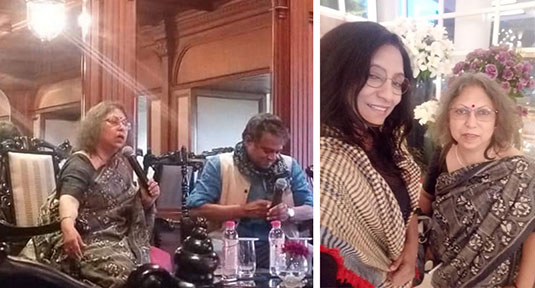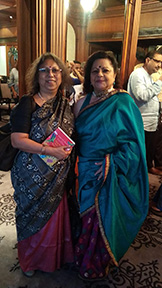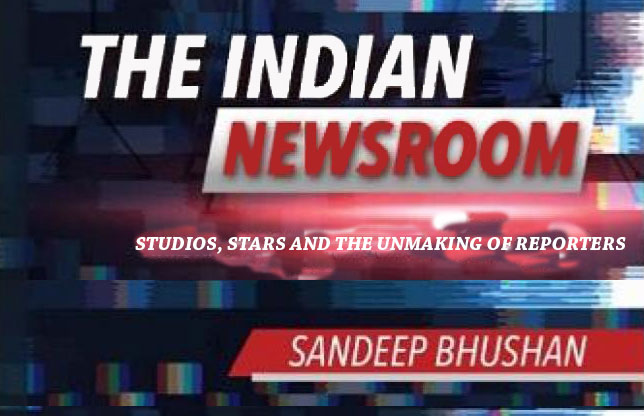August 1 this year saw journalist Ravish Kumar being awarded the 2019 Ramon Magsaysay Award—the Asian equivalent of the Nobel Prize—for “harnessing journalism to give voice to the voiceless.” That is the ideal with which I had joined journalism, this very month of 1978.
More than 40 monsoons have gone by since I had crossed the threshold of the Indian Express group as a Trainee Sub Editor. The compositors who would arrange the letters of the alphabet to read the matter we had churned out—and send out galleys that were to be subjected to minimum editing so as to avoid much alteration—are now an extinct species. Though I started as a sub—a backroom job that mostly involved ‘crossing the ‘T’s and dotting the ‘I’s—I was soon in the field reporting, thanks to BK Karanjia who joined Screen at that juncture. The result? I got to interact with giants of moving images like Peter Ustinov, Nutan, Krzystof Zanussi, Shyam Benegal, Girish Karnad, Basu Bhattacharya and Naseeruddin Shah. At the same time I also wrote a column ‘They Also Serve‘ on the invisible backbones of the celluloid world: Men who lit up the floor from the catwalk, or wielded the scissor in the edit room; those who styled hair, or designed costumes; some served tea or provided furniture; some arranged music, some were stuntmen, some simply ushered viewers into auditoria…
Many of these rose to be stars in their own right, while so many disappeared from the scene with the digitization of Celluloid. That is not all: Much like cinema, journalism itself has changed since 1978. We who started with newsprint have lived through television, fought the advent of colour on the small screen, coped with the proliferation of commercials on the idiot box, been awed by the satellite revolution, tolerated the mushrooming of private channels, appreciated the growth of regional languages, overcome by the emergence of the Internet, wondered at the dawn of online platforms—and succumbed to the reign of the Social Media….
 I was therefore delighted to be invited by the Kolkata-based Prabha Khaitan Foundation to converse with Sandeep Bhushan, author of The Indian Newsroom: Studios, Stars and the Unmaking of Reporters. The author is a television journalist who has worked with pioneering satellite broadcast news channels like NDTV and Headlines Today; written on media for the Economic and Political Weekly, Hindu, Wire and Scroll—and taught at Jamia Millia Islamia, among others. His account of Indian television newsroom is, in many ways, the story of post-liberalisation India itself. “In just two decades, the country grew from the state-owned Doordarshan’s monopoly to a market dominated by umpteen private news channels,” he points out. “English language news has a particularly interesting trajectory here, both because of its disproportionate influence on the national conversation and its proximity to power,” he adds.
I was therefore delighted to be invited by the Kolkata-based Prabha Khaitan Foundation to converse with Sandeep Bhushan, author of The Indian Newsroom: Studios, Stars and the Unmaking of Reporters. The author is a television journalist who has worked with pioneering satellite broadcast news channels like NDTV and Headlines Today; written on media for the Economic and Political Weekly, Hindu, Wire and Scroll—and taught at Jamia Millia Islamia, among others. His account of Indian television newsroom is, in many ways, the story of post-liberalisation India itself. “In just two decades, the country grew from the state-owned Doordarshan’s monopoly to a market dominated by umpteen private news channels,” he points out. “English language news has a particularly interesting trajectory here, both because of its disproportionate influence on the national conversation and its proximity to power,” he adds.
Bhushan’s history of the industry scans the profession. More specifically, it takes a resolute look at what caused the marginalization of the reporter. “How did technology impact the newsroom?” he poses. “How did India evolve the star system? What is access journalism, and what is wrong with it? Is the reporter-editor relationship necessarily adversarial? How does the owner-editor system—perhaps unique to India—work in practice? And corporate ownership—is it a boon or a bane?” Finally, he asks, “How does India compare with UK or USA—countries that have a longer history of television news and more mature markets?
My years in journalism witnessed the Indian newsroom change irreversibly with the advent of the colour television. More so, with the growth of the Private Channels. Though owned primarily by those who were already big in Print Journalism—The Times of India group, the India Today group, the Ananda Bazar Patrika group, Eenadu TV overshadowed the earlier modes of mass communication. Radio in particular suffered until FM came to India—again piggy-riding the news moguls. However the print media changed its stripes and managed not only to survive but also to emerge bigger in certain ways. Its outreach increased as more and more regional players entered the arena. This was the obvious fallout of TV’s impact. Equally big was the way it altered the complexion of Mainstream cinema.
Satellite television can claim credit for changing everything. Prior to its appearance, when Doordarshan alone ruled, we had Video Magazines such as Newstrack—a sister publication of India Today—which recorded the poll mayhem at Meham in Haryana of 1990, something that would never be seen on DD. However the advent of Satellinte TV took to every home earth-shaking events like the armed Kargil conflict along the LOC between India and Pakistan in the summer of 1999, the Kandahar hijack involving the Indian Airlines flight 814 that led to the release of three marked terrorists including Masood Azhar—the architect of the Mumbai attacks—in December 1999, and the World Trade Centre attack in New York of September 2001.
Given the immediacy of these events, and their unpredictable denouement, these developing stories were more gripping than any thriller on the silver screen. I for myself couldn’t take my eyes off the large screen on the second floor of the Times House in Delhi as the second tower of the WTC came crumbling down in New York. The story of the man stabbed inside the plane grounded in the Taliban-ruled Afghanistan city on a New Year’s Eve was heart breaking. We debated in high pitched voices whether the government should hand over the three men they—the terrorists supported by ISI of Pakistan—want to free? Kargil was the War Movie we could participate in from the safety of our own homes. Did these live reports sensitise us or do the opposite—desensitize us to War and Terrorism? And increasingly pertinent, perhaps, is the question: Should TV desist from showing things that are ‘against our national interest’?
Closer home, colour television took films into our bedrooms, and that adversely affected not only the economy of cinema but also its content. By all accounts it had to become BIGGER and GLOSSIER. And, while we had channels serving content in Marathi, Bengali, Malayalam, Tamil, Oriya, Assamese—every language worth its salt—Doordarshan did away with the Sunday afternoon screening of Regional films that had given cross-country eminence to directors in the languages and made stars of Adoor Gopalakrishnan, Balu Mahendra, John Abraham, Jahnu Barua, Nirad Mahapatra, Buddhadev Dasgupta, Goutam Ghose… Soon Romedy and Thrillers came to be the staple of Prime Time tele-viewing.
 So many other things altered. When we were students, we watched Models grow up into Actors, like Shekhar Kapur. The idiot box changed the template, and soon even a veteran, nay, venerated actor like Amitabh Bachchan was selling Mirinda and Cadbury, Dabur, Emami, Kalyan Jewellery, Maggi Noodles, Parker Pen and Navaratna oil, ICICI Bank to firstcry.com… And Lambuji wasn’t the only player in the arena: Amir Khan, Akshay Kumar, Ajay Devgn, Shah Rukh Khan—you name them, and they were on the screen. Because? Franchise companies found that viewers developed a greater bond with the product if an actor they empathized with endorsed it. Print was stilled life; television was life lived, even if not king size…
So many other things altered. When we were students, we watched Models grow up into Actors, like Shekhar Kapur. The idiot box changed the template, and soon even a veteran, nay, venerated actor like Amitabh Bachchan was selling Mirinda and Cadbury, Dabur, Emami, Kalyan Jewellery, Maggi Noodles, Parker Pen and Navaratna oil, ICICI Bank to firstcry.com… And Lambuji wasn’t the only player in the arena: Amir Khan, Akshay Kumar, Ajay Devgn, Shah Rukh Khan—you name them, and they were on the screen. Because? Franchise companies found that viewers developed a greater bond with the product if an actor they empathized with endorsed it. Print was stilled life; television was life lived, even if not king size…
Fallout? An unthinkable spurt to the Celebrity Culture. Even in Print journalism, where it was not customary to see the mug of the writer, the editorials, the debates and opinions, the views and counter views— the Think pieces—on Budget days or otherwise, started giving preference to cricketers, actors, politicians. Inevitably the Glamour Quotient became more important than the Academic specialization or Depth of Opinion.
Then, Headlines started to become the Content of the entertainment industry, taking it away from literature and its classics. Cinema gained Immediacy, but was it at the cost of processed observation? May or may not be so. This year’s National best, Uri: The Surgical Strike, unfolds around Major Vihaan Singh Shergill of the Indian Army who led a covert operation against a group of militants who attacked a base in Uri, Kashmir just three years ago, and killed many soldiers. Black Friday, made in 2004, is stuff of tele journalism. For it tracks the massive drive the police forces launched after the 1993 bomb blasts ripped Mumbai apart, yielding the names of the perpetrators of that terror act. Mumbai Meri Jaan, the 2009 film that won multiple Filmfare awards, was built on the aftermath of the multiple train bombings that rocked the Financial Capital of India in July 2006.
Last year Hotel Mumbai set adrenalin flowing as it tacked members of Lashkar-e-Toiba who stormed the Taj Mahal Hotel and let loose gunfire and mayhem across the city, across the country, across the globe. The drama gained an emotional pitch that a documentary—or a tele-reporting—cannot achieve, by tying in the story of a brave chef and his staff who risk their lives while a desperate couple do what they can to protect their newborn. Batla House, Article 15, even No One Killed Jessica, the mowing down of pavement dwellers by a limousine—these are the brick and mortar of Tinseltown today, not boy-meets-girl or dancing-around-trees. [highlight background=”#f79126″ color=”#ffffff”]Any doubt that the success of television in grabbing eyeballs gave these directors the idea?[/highlight]
In fact, the burgeoning of the Sports channels and the larger than life reporting of sporting events has given a spurt to films on cricket and hockey and even wrestling and boxing. Indirectly or otherwise, it has spawned Biopics on sportspeople—Flying Sikh Milkha Singh, ‘Soorma’ Sandeep Singh, athlete Paan Singh Tomar, wrestler Mahavir Singh Phogat and his daughters Geeta Kumari and Babita Kumari… They are the role models from the Sports pages, while Neerja about the courageous air hostess and Parmanu: The Story of Pokhran on IAS officer Aswath gave new heroes to the entire nation.
This makes me wonder why television no longer has any intrepid reporters going after corrupt lots in power, nor any channel dedicated to Investigative journalism. During the recent Doctors Strike, no camera went behind the beds in the government hospitals to check what is lacking in the OTs, the testing labs, the pharmacies… Yet, we haven’t forgotten that channels gave Bollywood the role model of an Intrepid Lady Journalist in the mold of Barkha Dutt. Was that due to the rise in the numbers of women anchors? Can women take a stronger stance with a soft smile playing on their face? Or do women—traditionally seen as more vulnerable—make more interesting protagonists?
This brings us to the critical concern of commercials. Granted, they have been the grooming ground of celluloid masters from Satyajit Ray to Shyam Benegal, Mukul Anand to Rakeysh Omprakash Mehra, Rajkumar Hirani to Balki, Pradeep Sarkar to Shoojit Sircar, Aniruddha Roy Chowdhury to Nitesh Tewari. Yes, the Jackie Shroffs, Arjun Rampals, John Abrahams and Rajkumar Raos have also shed their jeans and suitings to rise-n-shine. But since the commerce of the channels depends on these commercials, Indian Television does not scan the pros and cons of the Business World the way business channels abroad do. How many has telescoped the malpractices within a Kingfisher, or of Only Vimal?
Nor for that matter do we boast a Science channel although we have a number of them for Astha (confidence) in Faith. That is why we have drab statements reading out that India launched yet another Satellite without a hint of the excitement that prompts Hollywood to invest millions and zillions in Space Adventure flicks. They have taken a leaf out of the engrossment we felt full 50 years ago, when The Times of India spread out the image of Neil Armstrong and Edward Aldrin walk on the Moon.
Is that why, despite the Magsaysays under our belt, we have yet to offer a desi Steven Spielberg?
See also
https://filmcriticscircle.com/journal/patriotism-in-the-cinema-of-hindi/






Leave a Reply
You must be logged in to post a comment.